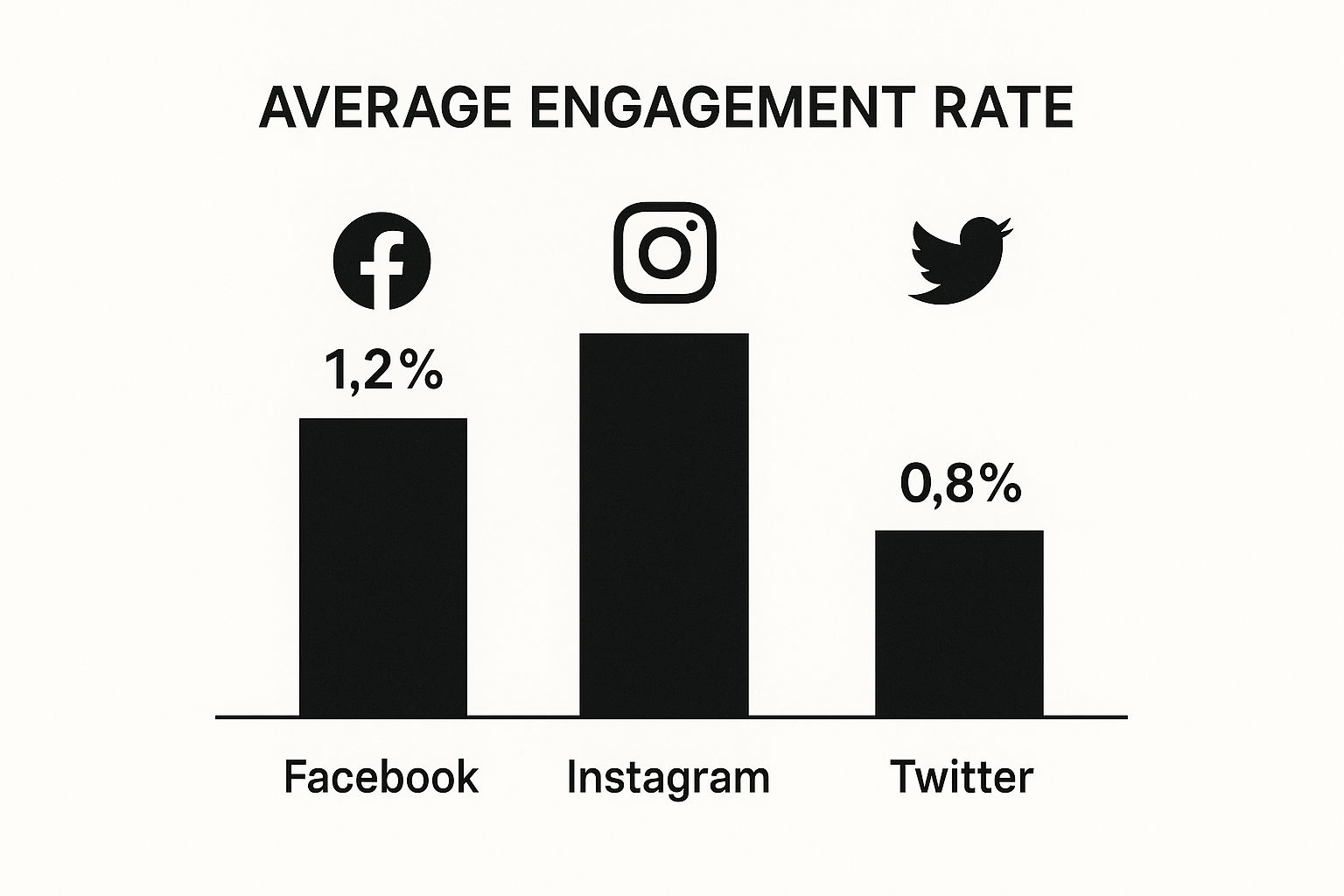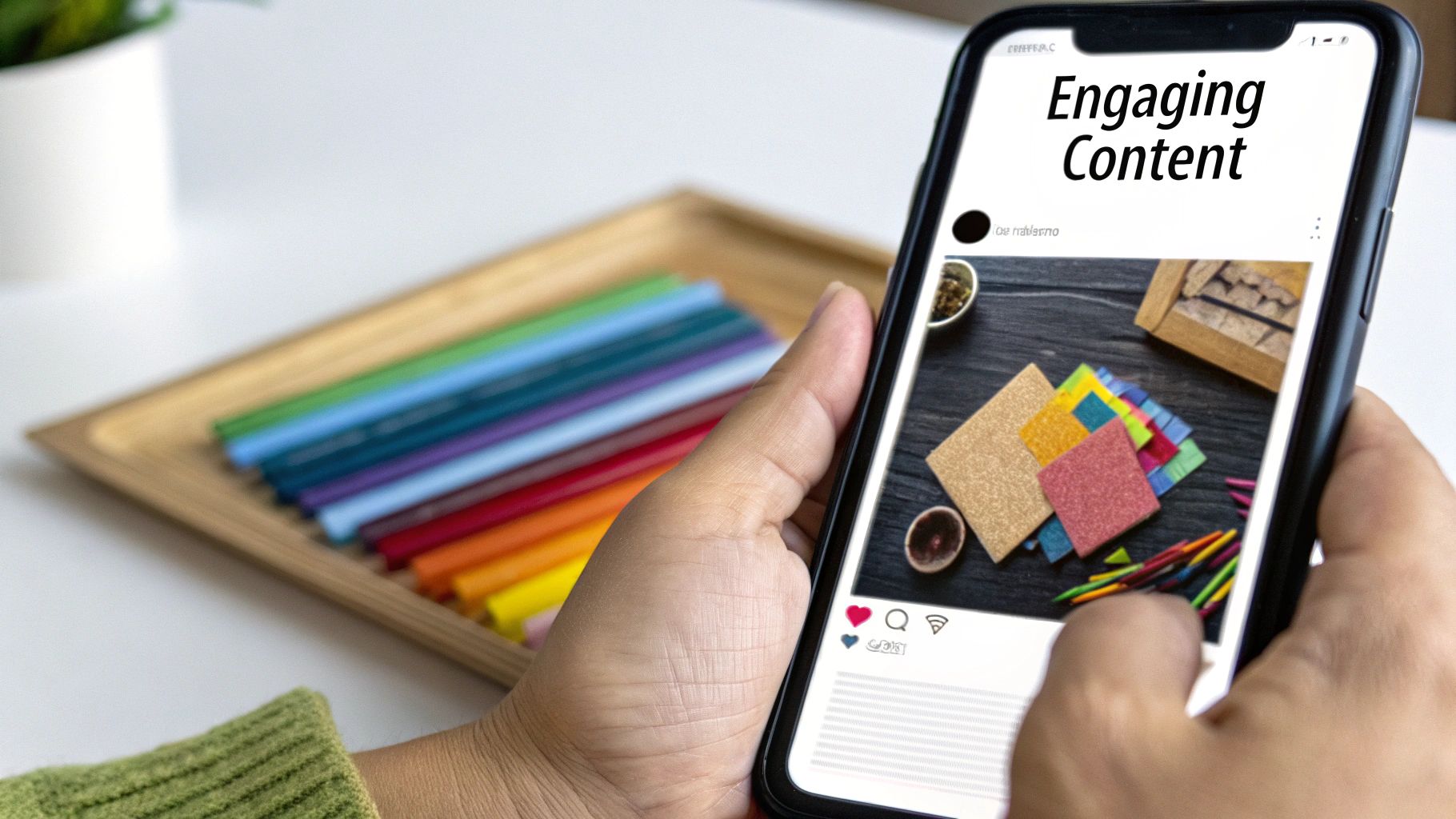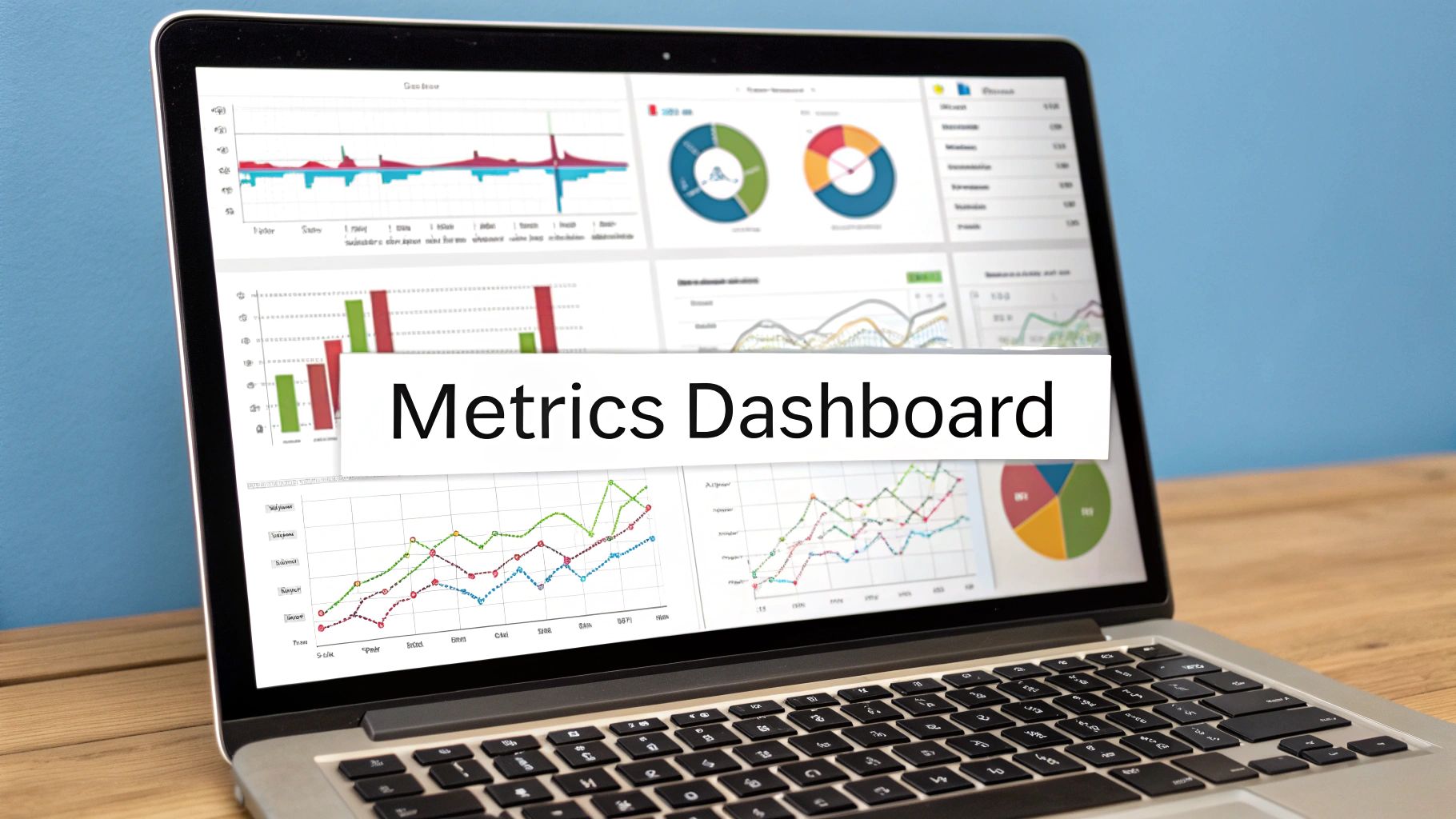
Small Business Social Media Strategy That Works
Published on 2025-09-18
For a small business, social media is so much more than just a place to post updates. Think of it as your digital storefront and your community gathering spot, all in one. It’s hands-down the most direct way to get your name out there, truly connect with your customers, and grow your business without needing a huge marketing budget.
Why Social Media Is a Game Changer for Small Business

Imagine social media as your town square. It’s the place where you can share your story, chat directly with the people who buy from you, and build a base of loyal supporters. For a small business owner, this isn't just another item on an endless to-do list—it's a serious engine for growth that puts you on more even footing with bigger competitors.
A great social media presence works like a 24/7 storefront, always open and ready to show off your products, services, and what makes your brand unique. It’s also a direct line to your customers, giving you a chance to hear their feedback, make improvements, and show them you’re listening. That back-and-forth conversation is where the real magic happens.
Building Authentic Connections
At its heart, small business social media is all about building genuine relationships. It’s how you turn a first-time customer into a devoted fan who comes back again and again—and tells their friends about you. When you share behind-the-scenes glimpses, celebrate your customers' stories, and have real conversations, you build a level of trust that a traditional ad just can't buy.
This connection-first mindset is central to modern marketing. The numbers back it up: by 2025, it's expected that over 96% of small businesses will be using social media. The perks are pretty clear, too. 83% say it boosts their brand's visibility, 73% see more traffic to their website, and 65% generate more leads.
The Ultimate Competitive Advantage
As a small business, your biggest advantage isn’t a bottomless budget; it’s your ability to be nimble and real. You can connect with people on a personal level that large corporations often find impossible to match. This authentic interaction is what truly makes you stand out and builds a community that wants to see you succeed.
A lot of people think you need to "go viral" to win at social media. The truth is, consistently creating valuable content for the right audience will always beat a one-hit wonder in the long run. Focus on building a community, not just chasing clicks.
To really tap into this power, you need a solid plan. For small businesses looking to make the most of their online presence, it's worth checking out a comprehensive social media marketing strategy playbook. Having a clear strategy makes sure your efforts are focused, efficient, and directly tied to your business goals, turning your social channels into a reliable source of growth.
2. Choosing the Right Platforms for Your Brand
Jumping onto every social media platform is a classic small business mistake. It’s like trying to set up a market stall in every town square at once—you’ll spread yourself too thin and won't connect with anyone. The real key is choosing the right battlegrounds where you can actually win.
Instead of a scattergun approach, success comes from being deliberate. You need to pick the platforms where your ideal customers are already spending their time and where your brand's story can shine brightest. This isn't about being everywhere; it's about being in the right places, consistently.
Find Your Audience First
Before you create a single profile, the first question to answer is simple: Where do my customers hang out online? Different platforms attract different crowds. Trying to sell high-end B2B consulting services on TikTok is an uphill battle, just as promoting a trendy, youth-focused clothing brand exclusively on LinkedIn would completely miss the mark.
Think about your ideal customer. Are they professionals looking for industry insights? They’re likely on LinkedIn. Are they homeowners searching for renovation inspiration? Pinterest is probably their go-to. Young adults looking for quick, entertaining videos are scrolling through TikTok and Instagram Reels.
Your goal isn't to reach everyone. It's to reach the right people. Focusing your energy on one or two platforms where your target audience is highly active will deliver far better results than a weak presence on five or six.
Once you know where they are, you can start thinking about the best way to talk to them.
Match the Platform to Your Content Style
The second critical question is: What kind of content best tells my story? Every social media platform has its own language and preferred style. A visually-driven business, like a local bakery or a custom furniture maker, will naturally thrive on platforms that put beautiful images and videos front and center.
For example:
- Instagram & Pinterest: These are perfect for brands with strong visual appeal. Think restaurants, fashion boutiques, artists, and travel companies. High-quality photos, carousels, and short videos are the name of the game here.
- LinkedIn: This is the undisputed champion for B2B companies, consultants, and service-based professionals. It’s the ideal place to share industry articles, case studies, and thought leadership content that builds authority and trust.
- Facebook: With its diverse user base, Facebook is a great all-rounder. It works well for building local communities, running targeted ads, and sharing a mix of content, from customer testimonials to event announcements.
- TikTok & YouTube Shorts: If your brand has a personality that shines in short, engaging, and often humorous videos, these platforms are powerhouses for reaching a broad audience quickly.
Trying to force long, text-heavy posts onto a visual platform just doesn't work. It’s about fitting in naturally.
Align Platforms with Your Business Goals
Finally, ask yourself: What do I actually want to achieve? Your social media activity should directly support your core business goals. Are you trying to drive foot traffic to your physical store, generate online sales, or book client consultations?
Your primary goal will point you to the right platform. If your main objective is e-commerce sales, platforms with robust shopping features like Instagram and Facebook Shops are a no-brainer. If you're focused on generating leads for a service business, LinkedIn's professional network offers incredible targeting.
To give you a better idea, here's a quick guide to help you compare the major players at a glance.
Platform Selection Guide for Small Businesses
| Platform | Primary Audience | Best Content Format | Ideal For |
|---|---|---|---|
| Broad (Gen X & Millennials) | Videos, curated content, community posts | Building local community, customer service, targeted ads | |
| Millennials & Gen Z | High-quality photos, Reels, Stories | E-commerce, visual branding, influencer marketing | |
| Professionals, B2B decision-makers | Articles, case studies, company news | B2B lead generation, networking, building authority | |
| TikTok | Gen Z & younger Millennials | Short-form, entertaining videos, trends | Brand awareness, viral marketing, user-generated content |
| Predominantly female, homeowners | Infographics, tutorials, product photos | Driving website traffic, visual discovery, e-commerce | |
| YouTube | Wide demographic | Long-form videos, tutorials, vlogs | In-depth explainers, product demos, building trust |
Choosing the right mix based on your unique business is the first real step toward a social media presence that actually works for you.
This chart shows how differently users engage with content across platforms.

As you can see, a platform like Instagram often fosters higher interaction, which is golden for brands focused on building an engaged community. By carefully selecting your platforms based on audience, content, and goals, you create a focused small business social media strategy that saves you time and delivers real impact.
Crafting a Content Strategy That Connects

Great content never just happens. It’s the direct result of a smart, well-thought-out plan. If you’re a small business, trying to pull brand-new post ideas out of a hat every single day is a one-way ticket to burnout. The trick is to stop thinking post-by-post and start thinking in themes.
This is where content pillars come into play. Think of them as the main topics or buckets of ideas your brand will talk about over and over again. They’re the foundation of your content house, making sure everything you post feels connected and serves a purpose.
A local coffee shop, for instance, might build its strategy on these pillars:
- Our Coffee: Diving into bean origins, different brewing methods, and new seasonal drinks.
- Community Spotlight: Featuring local artists, loyal regulars, and other neighborhood businesses.
- Behind the Scenes: Giving a peek at the baristas in action, the baking process, and the daily hustle of shop life.
These pillars become your well of inspiration, making it so much easier to plan content that your audience actually wants to see.
Building Your Content Calendar
Once you’ve settled on your pillars, it's time to get organized with a content calendar. A calendar isn't some rigid rulebook designed to stifle your creativity. It’s a time-saving machine that saves you from that daily "what on earth do I post today?" panic.
Your calendar can be as simple as a spreadsheet, a Trello board, or a dedicated scheduling tool. The point is to map out your posts a week or even a month ahead of time. This guarantees you have a healthy mix of content and can post consistently—a huge factor in getting social media algorithms to show your stuff to more people. For a deeper look, our guide on https://autoghostwriter.com/blog/social-media-content-planning is a great resource.
A content calendar turns social media from a reactive chore into a proactive strategy. It gives you the breathing room to be creative and thoughtful instead of just scrambling to get something online.
Think of your social media content as a key part of your wider small business content marketing plan. It’s the bridge connecting your brand to your customers.
The Perfect Content Mix
Let’s be real: not every post should be a sales pitch. In fact, most of them shouldn't. A winning social media strategy balances different kinds of content to keep your audience hooked. A fantastic guideline to follow is the 80/20 rule.
The idea is simple: 80% of what you post should deliver pure value—whether that’s educating, entertaining, or inspiring your audience. The other 20% can be promotional, where you talk directly about your products, services, or special offers.
This approach builds a ton of trust. You become a helpful resource, not just another business trying to make a sale. When you finally do post a promotion, your audience will be way more open to it because you've already given them so much.
Work Smarter, Not Harder, with Repurposing
One of the best-kept secrets to staying sane with content creation is repurposing. You don't need a hundred new ideas every month. You just need a few great ones that you can slice, dice, and adapt for different formats and platforms.
Think of a single core idea as a block of clay. You can shape it into all sorts of different things.
Example: Repurposing a Customer Success Story
- Core Idea: A happy customer shares their success story.
- Long-Form Content: Write a detailed blog post about their journey.
- Short-Form Video: Create an Instagram Reel or TikTok with a quick, punchy testimonial quote.
- Image Carousel: Design a multi-slide Instagram post highlighting key takeaways with cool graphics.
- Quote Graphic: Pull the most powerful sentence from their testimonial and turn it into a shareable image for Facebook.
- Behind-the-Scenes Story: Share candid photos or clips from the customer interview on your Instagram Stories.
This lets you turn one piece of work into a full week’s worth of content. You save a massive amount of time while making sure your message reaches the widest possible audience. It’s a crucial tactic, especially now—as of 2025, with over 5.42 billion active users, social media is more crowded than ever.
Building a Community, Not Just a Following
The best brands on social media get one thing right: it’s not a megaphone, it’s a telephone. Your goal isn't just to shout your message at a massive audience. It's to talk with them, creating a space where people feel like they actually matter to you. A big follower count looks good, but an engaged community is what actually grows a business.
Think of yourself as the host of a killer party. You don't just send the invites and disappear. You greet people at the door, get conversations going, and make sure everyone feels welcome. That's the real difference between having followers and building a community.
Sparking Two-Way Conversations
Community is built on conversation, plain and simple. Just posting content and hoping for likes is a surefire way to have a silent audience. You have to actively pull people into the discussion.
This doesn't have to be some grand, complicated strategy. It often starts with simple, open-ended questions. Instead of just posting a slick photo of your new product, ask your audience how they'd use it or what features they'd love to see you add.
A brand that only talks about itself is like that person at a party who won't stop talking about their job. You might nod politely for a minute, but you're not going to stick around. Real connection starts with being genuinely curious about the other person.
When you shift from broadcasting to conversing, you start building actual relationships.
Practical Ways to Build Your Community
Getting your followers to become active participants takes consistent effort. The key is creating experiences they actually want to be a part of. Here are a few proven tactics any small business can start using today:
- Run Polls and Quizzes: These are easy, low-effort ways for people to weigh in. Ask for opinions on a new logo, run a fun quiz about your industry, or post a simple "this or that" question.
- Showcase Your Customers: User-generated content (UGC) is pure gold for community building. When a customer posts about your product, share it! This gives you amazing, authentic content and makes that customer feel like a rockstar.
- Ask for Feedback (and Actually Listen): Make it clear that your audience's opinions count. Ask what they want to see from you, what they're struggling with, or how you can make things better. And when you can, act on what they tell you.
These little actions send a powerful message: you see your followers as partners, not just as numbers on a dashboard. To dive deeper, you can explore a whole range of audience engagement strategies that help build these vital connections.
Turning Negatives into Positives
Look, no business is perfect. Sooner or later, you’re going to get a negative comment or a customer complaint on one of your social channels. It's easy to panic, but this is actually a massive opportunity to build trust.
How you respond changes everything. Deleting bad comments or getting defensive is a quick way to torpedo your reputation. The right move is to handle it with empathy and a genuine desire to make it right.
A Simple Plan for Handling Negative Feedback:
- Acknowledge Publicly: Jump on the comment quickly and politely. Thank them for the feedback and let them know you hear their frustration.
- Move Privately: Offer to solve the problem in a direct message or over email. This moves the nitty-gritty details out of the public eye while showing everyone that you're on it.
- Follow Through: This is the most important part—actually fix the problem. A customer whose issue gets resolved with care often becomes your most loyal fan.
When you handle a complaint with grace, you're not just solving one person's problem. You're showing your entire community that you stand by your products and truly care about their experience. That builds loyalty that a picture-perfect feed never could.
Making Social Media Ads Work on a Small Budget

The thought of paying for social media ads can be daunting, especially for a small business. You see the big brands throwing around huge sums of money and figure it's a game you can't afford to play. But here’s the thing: you don't need a massive budget to see incredible results. With a smart approach, paid ads can become one of your most powerful tools for growth.
Think of it this way: your regular, organic social media posts are like building a great reputation through word-of-mouth. It works, but it takes time. Paid ads are like putting up a billboard on the busiest street in town—a street you know your ideal customers walk down every single day. It’s all about getting your message in front of the right people, right now.
The real magic of small business social media advertising isn't about outspending your competition. It's about precision. You're not just shouting into the void and hoping for the best. You can handpick your audience based on their interests, where they live, how they shop, and so much more.
Start Small and Test Everything
For any small business just dipping a toe into paid ads, the golden rule is this: start small, test relentlessly, and then double down on what works. You absolutely do not need to commit thousands of dollars right out of the gate.
In fact, spending as little as $5 to $10 a day can give you a ton of valuable feedback. It’s enough to see what your audience actually responds to. This approach keeps your risk low while your learning curve goes way up. You can run little experiments to figure out which ad copy, images, or target groups give you the best bang for your buck. Once you find a winning formula, that's when you can start to increase your budget with confidence.
The goal of your first few ad campaigns isn't necessarily to make a million dollars overnight. It's to gather intelligence. Every click, impression, and conversion is a piece of data that makes your next campaign smarter and more effective.
Let's say a local bakery runs two simple ads. They're identical, except for the image. One shows a beautifully decorated cupcake, and the other shows a happy customer taking a bite. By spending just a little bit of money, they can quickly see which visual gets more clicks and then put more ad spend behind the winner. This "test and learn" cycle is the secret to getting the most out of every dollar.
Laser-Targeting Your Ideal Customer
The single most important part of a successful ad campaign is targeting. Platforms like Facebook and Instagram have built incredibly powerful tools that let you create a custom-made audience for your ads.
You can get amazingly specific. Here are just a few of the ways you can zero in on your audience:
- Location: Target people within a certain radius of your shop—say, 5 or 10 miles.
- Demographics: Focus on specific age ranges, genders, job titles, or even life events like getting engaged.
- Interests: Reach people who have shown an interest in things related to your business, like "organic coffee" or "hiking gear."
- Behaviors: Target based on online activities, like people who have made a purchase online in the last month.
This level of detail means your money is spent showing ads to people who are most likely to care about what you're selling. It’s a world away from taking out a newspaper ad and just hoping the right person happens to see it.
Of course, you need to understand the costs. The average global social media ad spend per user is around $46.47, but that number can swing wildly depending on where you are and who you're targeting. More practically, the average cost for 1,000 impressions (CPM) was about $5.69 near the end of 2024, which was actually a slight drop from the year before. This shows that costs are manageable and that a smart strategy can be very efficient. You can discover more about these global digital trends to get a better handle on budgeting for your own campaigns.
Measuring What Matters for Your Business Growth
So, you're putting in the work on social media. But how do you actually know if it's paying off? It's easy to get caught up chasing likes and followers, but those are often just vanity metrics. They look impressive on the surface but don't always connect to real business results.
True growth comes from tracking the numbers that actually move the needle for your company.
Think of it this way: likes are like people smiling as you drive by. It's nice, but it doesn't tell you if you're getting any closer to your destination. What really matters are your speedometer (sales) and your fuel gauge (return on investment). For your small business social media, you need to focus on that same kind of essential dashboard.
This all comes down to tying your social media activity directly back to your business goals. Every goal has specific numbers—or key performance indicators (KPIs)—that show you whether you're succeeding or just spinning your wheels.
Aligning Metrics with Your Goals
If you're trying to boost brand awareness, your goal is to get your business in front of new eyes. The metrics you'd watch for that are completely different than the ones you'd track for generating sales.
Here’s a quick guide to matching your goals with the right data:
- Goal: Brand Awareness: Keep an eye on reach (the number of unique people who see your content) and impressions (how many times your content was displayed). If these are climbing, you’re successfully expanding your audience.
- Goal: Community Engagement: This is all about the interactions. Track comments, shares, and saves. These actions signal that people find your content valuable enough to engage with or save for later.
- Goal: Website Traffic: The magic number here is your click-through rate (CTR). It tells you the exact percentage of people who saw your post and were compelled enough to click the link to your website.
- Goal: Lead Generation: Focus on conversion rates. This could be how many people filled out a contact form, downloaded a free guide, or signed up for your email list from a social media post.
Measuring the right KPIs transforms social media from a guessing game into a predictable growth engine. It allows you to stop wasting time on activities that don't work and double down on the ones that do.
Finding Insights in Platform Analytics
The good news? You don’t need to buy expensive software to get started. Every major platform comes with its own powerful and free analytics tools. Meta Business Suite (for Facebook and Instagram), Instagram Insights, and LinkedIn Analytics offer a goldmine of data.
Set aside some time each month to dig into these dashboards. You're looking for patterns. Which posts sent the most people to your website? What kind of content got the most shares? This data is direct, actionable feedback from your audience.
When you use these insights to make decisions, you start to systematically improve your strategy over time. For a more detailed breakdown, our guide on how to measure social media ROI offers a deeper dive into connecting your efforts to real financial returns. This ensures your social media isn't just busywork—it's a measurable investment in your business's future.
Got Questions About Social Media? We've Got Answers
Stepping into social media for your small business can feel like opening a can of worms. Suddenly, you're wondering about everything from how to find the time to what to do when someone leaves a nasty comment. It's totally normal to feel a bit lost, so let's clear up some of the most common questions.
How Much Time Does This Really Take?
This is the big one, isn't it? For a busy business owner, time is everything. But the answer isn't about clocking a certain number of hours; it's about working smarter, not harder.
The secret weapon here is content batching. Seriously, it's a game-changer. Block out a few hours one day a week to get all your posts planned, written, and scheduled. Suddenly, social media isn't a nagging daily chore but a focused, manageable task. From there, just 20-30 minutes a day is often plenty to hop in, reply to comments, and chat with your followers.
What Happens When I Get Negative Comments or Trolls?
Sooner or later, it's going to happen. But a negative comment doesn't have to be a disaster—in fact, it can be an opportunity. The way you respond shows everyone watching what your business is made of. The trick is to be quick, professional, and empathetic.
Never just delete criticism (unless it's offensive spam, of course). When you respond thoughtfully and try to fix the problem out in the open, you're not just talking to one unhappy person. You're showing your entire audience that you genuinely care and stand behind your business.
A great strategy is to acknowledge the complaint publicly with a simple, "I'm sorry to hear you had this experience, let's make it right." Then, ask them to send you a private message or email to sort out the details. This validates their feelings while moving the nitty-gritty of the conversation out of the public eye.
Do I Really Need to Be on Every Single Platform?
Let me shout this from the rooftops: Absolutely not! This is hands-down one of the biggest myths out there and a fast track to burnout. Spreading yourself thin across every platform imaginable means your content will be mediocre everywhere.
It's so much more powerful to be a big fish in a small pond. Pick one or two platforms where your ideal customers actually hang out and go all-in. A local pie shop will probably crush it on Instagram and Facebook with beautiful photos. A business consultant, on the other hand, should be building their network and sharing expertise on LinkedIn. Always choose quality over quantity.
Ready to create compelling LinkedIn content without the guesswork? autoghostwriter uses powerful AI to help you generate engaging posts that build your professional brand. Stop staring at a blank screen and start connecting with your audience today.